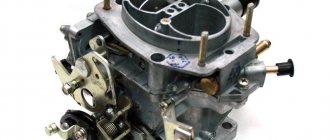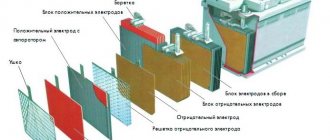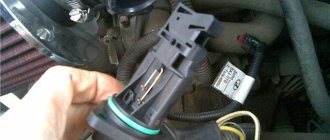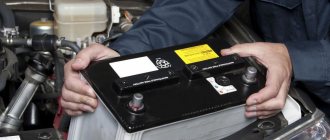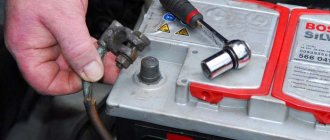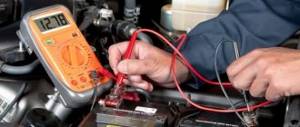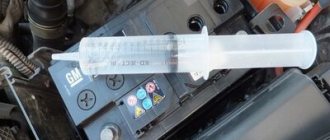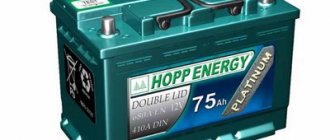Their shedding leads to the formation of so-called sludge. It is he who short-circuits the plates in the bank and prevents it from charging. The result is that the battery loses capacity and power. It can no longer cope with its responsibilities and is unable to provide the car with the required amount of current.
Why doesn't one jar boil when charging the battery? To answer this question you need to at least know the AB device. It would also be nice to get acquainted with the processes taking place in it.
Battery banks are shorted - symptoms
Here is a classic lead acid battery consisting of 6 cans. Each of them is composed of pairs of oppositely polar plates. Their contacts are collected into a common collector, connected in series and connected to the cover with two terminals. Modern cans have a different design, but the layout of the cans and cells is the same.
With a series connection, the cell voltages are summed up, and the capacity is determined by the most clogged bank. To charge the battery, voltage is applied to the terminals and current flows through the storage areas. Why do banks short circuit in a lead-acid battery? If for some reason the plates in the jar get closer together, the walls swell, a jumper is created, and the cell is closed. It happens that a contact bridge is created by a piece of crumbled putty or scale.
How can you check if the battery is short-circuited? When measuring the voltage at the terminals, a dip will be detected. For example, a 12 V battery consists of 6 cans with a total voltage of 2.1 * 6 = 12.6 V. The voltage drops to 10.5-11.0 V - look for a closed can.
One of the plates inside the jar is lead, and the other has a layer of active substance applied to it. If the electrolyte level is violated or overcharged, the mass may crumble and short-circuit the plates.
Mechanical damage from the outside can lead to deformation. It is possible that the battery case is swollen, and then internal short circuits of the plates in the banks are possible. This can happen when the electrolyte freezes and from overcharging a maintenance-free battery.
Symptoms of a shorted battery bank are loss of voltage, heating of the battery case. The battery does not charge to 12 volts, is unable to crank the starter, and requires replacement. Sometimes when charging you can hear the smell of rotten eggs - hydrogen sulfide gas is released.
Search
Normal battery parameters:
- open circuit voltage (OCV) 12.6 – 12.9 V
- electrolyte density 1.28 g/cm 3 (at +20°C)
- the voltage at the battery terminals when the engine is running at 1500-2000 rpm and the high beams are on is 13.9 - 14.3 V
When to charge the battery:
- electrolyte density below 1.26 g/cm3
- Open circuit voltage (OCV) is below 12.6 V
- The density of the electrolyte in different banks differs by more than 0.02 g/cm3
At a density of 1.2 g/cm 3 the freezing point of the electrolyte is about -20°C. Frozen electrolyte in the battery will render the battery unusable; a frozen battery cannot be restored, so do not leave a very discharged battery in the cold, but immediately take it indoors and charge it!
If in one of the cans the density of the electrolyte is significantly lower than in the others, this may serve as a signal of a possible internal short circuit of the battery plates.
How to charge:
Before charging a car battery, you must unscrew all the plugs and remove the lids of the cans.
- We charge the battery with a current equal to 0.05 of its rated capacity. For a battery with a nominal capacity of 55 Ah, the optimal charging current is 2.75 A.
- The maximum charging current is 0.1 battery capacity.
- The maximum voltage at the charger output is no higher than 14.4 V, it is better if it is possible to regulate the charge voltage.
- The lower the charging current, the deeper the battery is charged.
- Signs of charging completion: rapid gas release and no change in electrolyte density for 1-2 hours.
If the battery is partially (25%) discharged, the current at the beginning of charging when the charger is turned on may jump up sharply. We adjust it to a value no higher than 0.1 of the battery capacity or even less if the voltage at the battery terminals is close to 14V. For example, if the battery has a capacity of 55Ah, the maximum charging current is 5.5A. Further during the charging process, the voltage will increase and the current will decrease.
From time to time, it is advisable to equalize the density of the battery electrolyte using a small current, for example, if the density of the electrolyte in different battery banks differs by ±0.01 g/cm 3 . After turning on the charger, set the charging current to around 2A or lower. We charge the battery in this way for up to two days. This is especially necessary to do after the battery is completely drained as a result of repeated unsuccessful attempts to start the engine. And we do this without delay, before sulfation of the plates begins.
Battery manufacturers do not provide for the addition of any improving additives to the electrolyte; the electrolyte should consist only of distilled water and sulfuric acid, therefore, to bring the electrolyte level to normal, only distilled water must be added to the battery. Do not use tap water. If the electrolyte often boils away, you need to check the electrical equipment of the car.
It happens that when trying to charge a battery, its owner sees a lack of current on the charger. At the same time, the NRC of the battery does not exceed 10 V, and the density of the electrolyte is close to normal and approximately the same in all banks. In this case, there is an open circuit between adjacent battery banks.
Electrolyte density measurement.
The electrolyte density of a fully charged battery is 1.28 ± 0.01 g/cm 3 . If your electrolyte density is 1.20±0.01 g/cm3, then the battery is 50% discharged. A completely discharged battery has an electrolyte density of 1.10 ± 0.01 g/cm 3 . If there is a short circuit of the plates, the density of the electrolyte in the defective jar will be significantly lower (by 0.10-0.15 g/cm 3 ) than in the others.
A device called a hydrometer is used to measure the density of liquids.
When measuring, the float should float in the electrolyte without touching the walls of the hydrometer. We also measure the temperature of the electrolyte. We bring the density measurement result to +25 degrees Celsius by adding a temperature correction to the instrument readings, guided by the table:
Author:
Maxim Markov
Good day! All blog readers know that a serviceable battery requires periodic checks. After all, the concentration of sulfuric acid in it decreases over time. Therefore, every self-respecting motorist should know how to increase the density of the electrolyte in the battery. This is what we will talk about.
Signs of a shorted battery bank
Since charge is being redistributed inside, the battery case heats up, which is one of the signs of an internal short circuit. If the battery is serviceable, you can determine the shorted bank during charging. At the moment the voltage rises, the plugs on the cans are open, hydrogen is released from them, and the cans boil. If one does not show signs of life, it is closed. You can check and find the cause of undercharging of the battery in a ventilated area or outside.
If a voltage drop occurs in a maintenance-free battery, the device does not charge to operating voltage, as you can determine if the bank is shorted, or for another reason. Experts advise closing the contacts for 1-3 seconds. A copious discharge will begin from the non-working jar.
Even a maintenance-free battery allows you to see the electrolyte level in the jars through the translucent walls. Signs of a closed jar will be a reduced level of electrolyte - it boils away, sometimes a noticeable change in color to black.
Increasing electrolyte density
There are several jars in the battery; each of them contains an electrolytic solution. It is necessary to check and, if necessary, increase the density level in each jar.
The normal level of this indicator depends on several factors, primarily on air temperature. A value of 1.25-1.29 g/cm3 is considered normal. The difference in such indicators between banks should not exceed 0.1.
If the measurement of this indicator is below normal, you need to increase the density of the electrolyte in the battery.
Using a syringe, the solution is pumped out of each jar. In this case, you need to draw as much liquid as possible, measuring its volume, and then add exactly the same amount of fresh electrolyte.
Having filled in the same amount of fresh solution as the old one was removed, the battery is thoroughly pumped in order to mix the new and old electrolyte.
After this, this indicator is measured again: if it is still below the norm, all actions are repeated until the desired density value is achieved. Upon completion, distilled water is added to the car battery jars if necessary.
Reasons for the short circuit of cans in the battery
The main problem is failure to follow the operating instructions for the car battery. Closely spaced plates, active putty on the gratings, are precisely designed to work under the flood, with voltage within the permissible limits. The crumbled mass, sulfation, and a sharp blow to the body are a prerequisite for the contact of the plates with opposite charges. If one bank is overloaded, it will discharge faster, become sulfated, and the first one will fail.
What should I do to prevent the battery from shorting out and to keep it working for a long time? Keep the battery clean, avoiding unnecessary self-discharge currents. Do not leave a discharged battery for a long time without recharging. In the cold, a discharged battery will freeze because it contains a weak electrolyte. Often, just because of 1 cell of battery, you have to recycle the entire battery. There are several reasons why it can close:
- Factory defects are a warranty case.
- Strong blow to the body.
- Chronic undercharging and overdischarging is the most common cause of malfunction.
Recovering a shorted battery bank
Once it has been possible to understand that the car battery banks are shorted, it is necessary to evaluate the work to restore the cell and compare it with the purchase of a new device. If more than one can is shorted, there is no point in wasting time and effort on repairs. How do you know if there are still jumpers in other elements? They can appear if the layout of the case is disturbed or the connections are loosened.
Step-by-step instructions on how to restore a shorted battery bank.
- Identify a non-working jar based on the listed characteristics.
- Extract the electrolyte using special means, working in glasses and rubber gloves.
- Cut the plastic around the top of the cell.
- Disconnect the jumpers with adjacent elements and carefully remove the package of plates, rinse them from acid.
- Determine the location of the short circuit - a piece of metal, a bent plate, remove sediment at the bottom.
- Place the structure in place as it was, fill in the electrolyte, and secure the lid with glue.
- Fully charge the battery.
This is how lead batteries of older models and those produced in Europe are restored. Maintenance-free batteries must be protected from deep discharge. It is difficult to repair them yourself.
Video
It’s better to see once how specialists eliminate the consequences of shorted cans. How to restore a shorted battery bank, watch the video.
Topic in the “Audi Repair” section, created by serj32, January 5, 2011.
You are using an outdated browser. This and other sites may not display correctly. You need to update your browser or try using a different one.
When the electrolyte begins to boil when charging a battery, many car enthusiasts have questions about the possible consequences of this phenomenon. For each battery, such processes have different intensity: from the release of small bubbles to active seething. We'll tell you why this happens and what measures need to be taken in such cases.
Reasons for the boiling process
To understand whether a battery should boil at the end of charging, it is necessary to find out the reasons for the occurrence of this phenomenon, and for this let’s remember school courses in chemistry and physics. Modern cars use lead-acid batteries as a source of electricity. Most batteries have 8 or 6 sections (cans), each of which contains lead grids immersed in an electrolyte - an aqueous solution of sulfuric acid.
When a charger is connected, many chemical reactions occur inside the battery, but we are interested in the reaction that causes “boiling”. When current is applied to the lead grid, a chemical reaction occurs in the solution - electrolysis of water. The release of hydrogen and oxygen begins with a simultaneous increase in the density of the electrolyte. Motorists call this phenomenon boiling, although in our case this is not entirely true. The temperature of the hydrochloric acid solution does not reach the value at which boiling begins, and the observed processes are the release of detonating gas (a mixture of oxygen and hydrogen).
How to boost using a charger
Everything here is also simple, we need to charge the battery at a low current for a long period of time. The bottom line is this: when a full charge is reached, the electrolyte will begin to boil, bubbles will appear, it will disintegrate and the water will evaporate. To increase the density, we need the excess water to evaporate, but the acid remains. Of course, the level in the battery will drop - but instead of the lost level, we add the required electrolyte density. This process is long and tedious (boiling - adding), but after about a couple of days you can reach a density of 1.27 - 1.29 g/cm3, which is already normal.
As you can see, you can increase the density, and this process is often done with your own hands, but in different ways - choose the one you need.
Now a short but useful video.
And that’s all for me, read our AUTOBLOG.
( 27 votes, average: 4.07 out of 5)
Similar news
How much lead is in the battery. Let's look at car options.
What is an AGM battery? 8 fundamental differences of this technology.
How to check for current leakage in a car. Multimeter or simply.
What actions need to be taken?
The answer to this question depends on the intensity of gas emission, as well as on when the seething began. In a working battery, gases are released when the charge reaches 30%. This happens 2-3 hours after connecting the charger (charger). As the density of the electrolyte increases, the amount of gas released will increase. Normally, there should not be a lot of bubbling; a small amount of bubbles is acceptable and you should not be afraid of this. 3 hours after the start of boiling, you can turn off the electric current source.
Prolonged boiling of the electrolyte will damage the battery.
Avoid situations where the battery boils for more than three hours, this may harm its performance. In the best case, the electrolyte will partially boil away; for maintenance-free batteries, such a problem is fatal. In addition, if the electrolysis process is prolonged, the battery will fail. First, lead sediment will appear at the bottom of the cans, which can lead to short-circuiting of the electrodes, and then the lead plates will begin to deteriorate.
It should also be remembered that the oxyhydrogen gas released during electrolysis is dangerous. Follow these guidelines when charging batteries to extend battery life and protect yourself:
- Before starting charging, unscrew all plugs. This rule applies even to devices equipped with safety valves. They cope with their task during operation, but during charging they will become an obstacle to the release of gas;
- do not place the battery near sources of open or closed fire, do not smoke nearby, do not touch the terminals - this will protect against an explosion;
- Charge the battery in a well-ventilated area.
Leveling with a charger
Everything is simple here. The only condition is that you will need a charger for the car with strict regulation of the output voltage. Automatic chargers that reduce the current when fully charged are not suitable.
How to restore density:
- The battery is brought to full charge;
- when it is charged and begins to boil, the current strength decreases to 1-2 Amperes;
- The logic is simple - the battery boils, the water evaporates, the electrolyte concentration increases;
- evaporation time depends on the specific case and can last more than a day;
- when the level drops, the electrolyte is added and the density is measured;
- if necessary, the operation is repeated.
Of the minuses, it is worth noting that it takes a long time.
If the density is too low
How to equalize the density if it is too low? For example, if its value is below 1.18, the described methods will not work. You will have to drain the acid completely.
Let's figure out what to do in this case:
- the electrolyte is pumped out of the cans as far as possible;
- The battery is carefully turned over, and holes are drilled in the bottom in each can.
- It is advisable to do this in some container, for example a basin;
- after this, the battery is placed in a vertical position, and the remaining liquid is poured out of it;
- the battery is washed with distilled water;
- the holes are sealed and new solution is poured.
The plastic used to seal the holes must be resistant to sulfuric acid.
Sometimes there are situations when old batteries have no density at all. This indicates deep sulfation. In this case, more serious recovery measures will be required.
In fact, if the density of the electrolyte in your battery has dropped, this is not such a big problem. And you can lift it without much difficulty. But, only if you determine the drop in concentration in time. If you don’t take care of the battery, it will simply fail.
Surely most motorists have encountered a situation where a car left for some time stops starting. In this case, the starter may not show any signs of life at all. The main reason for this is most likely the battery, which was completely discharged in a few days. Trying to charge it in this case will not lead to a positive result. This problem is the result of a decrease in the density of the electrolyte that is poured into the battery banks...
THE CONTENT OF THE ARTICLE
After all, this liquid is essentially a catalyst for the electrochemical process; without it, the battery is a set of lead and plastic that will not work. As you and I know, it consists of distilled water (approximately 65%) and sulfuric acid (35%), this liquid has a certain density, which can decrease and increase, depending on the charge.
Troubleshooting Possible Problems
Motorists may experience a situation where boiling occurs, but the battery does not charge. This usually happens when the electrolyte level in the banks decreases. If the battery is maintenance-free, you will have to throw it away. In other cases, you can try to revive the battery using our instructions:
- unscrew one plug;
- carefully pour the electrolyte into a glass jar;
- pay attention to its color (normally transparent, when the plates fall off - dark);
- if the color has not changed, fill the electrolyte to the required level and tighten the cap;
- repeat the previous operations with each jar, then connect the charger.
This way you can determine what caused the problem. If the electrolyte is transparent in all banks, then the reason is a decrease in its level. This happens when the battery is stored for a long time, the seal of the case or plugs are broken. If the electrolyte is cloudy, this means that the lead plates have crumbled and a short circuit has occurred. If the damage is minor, you can try to repair the battery yourself.
Moderate boiling of the battery is normal.
Raising the electrolyte density in the battery
So, let's figure out how to increase battery density. I’ll say right away that although this is not a tricky task, it is quite painstaking and, moreover, takes a lot of time. Therefore, it is better to be patient in advance.
The normal electrolyte density should be in the range of 1.25-1.27 g/cm3. Moreover, this value should be the same for all cans. In order to increase the electrolyte concentration in the battery banks, a correction solution is used. If you want to prepare the mixture yourself at home, remember the sequence:
- The distillate is poured into the container, and sulfuric acid is added to it. If you do the opposite, the solution will begin to boil violently.
In addition, you will need:
- an aerometer with a bulb for pumping liquid out of cans;
- glass container for draining old electrolyte;
- beaker ;
- safety glasses, gloves.
It is also important to remember that the liquid may have different densities in the jars. Therefore, it makes sense to make a simple plate where to enter the measurement results for each jar - otherwise you can get confused.
I’ll make one important clarification right away. Some comrades, advising on how to increase the density in the battery, suggest completely pouring out the electrolyte and filling in a new one. And to do this, they recommend simply turning the battery over, pouring out the liquid and rinsing everything with distilled water. And as a result of such manipulations, one or more cans stop working.
Why is this happening? The fact is that lead sediment collects at the bottom. And if the battery is turned over, pieces of lead can fall between the plates and short-circuit them. Those. the bank stops working.
So, when the electrolyte density has dropped, there are several effective methods to raise it painlessly. Let's look at them.
While charging the battery, one can does not boil - searching for reasons
During the charging process, a situation may arise when one or two cans do not boil. This indicates a malfunction of the compartment - complete destruction of the lead plates or a short circuit between them. In the first case, the battery cannot be restored. Even if you manage to change the lead plates, after a while the next can will fail. The process will continue to increase, and the battery will still have to be thrown away.
By following the instructions above, you can determine the cause of the breakdown. When shorted between the plates, the electrolyte will not change its color. If this is exactly the case for you, then you can try to revive the battery:
- drain the electrolyte from the idle can;
- try shaking the battery, if the problem is caused by debris stuck between the plates, then when shaking it will fall to the bottom of the jar;
- rinse the compartment 2-3 times with boiled water;
- fill the washed jar with electrolyte of the required density;
- connect the charger and check if the battery is charging.
Reasons for a boiling car battery
- The most common cause of a battery boiling while the engine is running is a short circuit in one of the cans.
Unfortunately, this is a sign that the battery in the car has failed. It is worth noting that recently this has begun to happen not only on old batteries, but also on relatively fresh ones.
Very often the banks short out due to vibration of the power unit. Or because of a banal device defect. So if you bought a new battery, then take care to obtain a warranty for it.
Well, when the warranty period comes to an end, conduct a comprehensive test of it. Perhaps this will help you save the money you would spend on buying a new battery.
- The second most common problem is when overcharging occurs.
Recharging is the process of charging from a generator with currents whose voltage is higher than the standard ones.
This usually occurs due to a problem with the car's alternator. Typically, the standard charging voltage from the generator should not exceed 14.5 Volts.
It may be greater in cases where the voltage regulator on the generator is faulty. This malfunction can be eliminated by repairing the generator.
- On old batteries, the recharging process can occur not only when the plates in the bank are short-circuited, but also when the plates become sulfated.
Sulfation is a chemical process that produces lead sulfate on the surface of the plates.
In old batteries, so much lead sulfate accumulates that the charging current decreases. In this case, if the generator continues to produce a voltage of 14.5 V, the battery begins to boil.
- Another common reason, especially if the battery is no longer new, is a large load on the battery.
That is, if you have a lot of electrical consumers and they are all turned on, for example, high beams, air conditioning, wipers and others, and the battery is no longer fresh, then it will not cope with the load and will heat up and boil.
- Well, the least common reason, but not so rare, is insufficient ventilation of the battery. This occurs if the battery vent is clogged or if a non-standard battery is used, there is not enough space for ventilation near it.
Actually, these are all the main reasons for a boiling battery.
Let's sum it up
Now you know why the electrolyte boils while charging the battery. Boiling is a normal process that indicates that the battery has reached the required charge level. If you follow safety precautions and charging rules, this process does not pose a danger. As for troubleshooting if there is no boiling in one of the battery cans, it’s up to you to decide. Craftsmen are reluctant to undertake restoration, so if you feel that you may not be able to cope with the repair, buy a new battery and don’t suffer.
